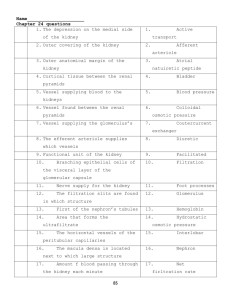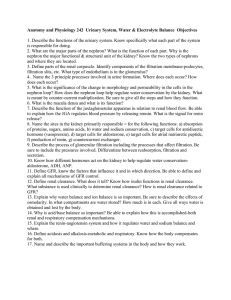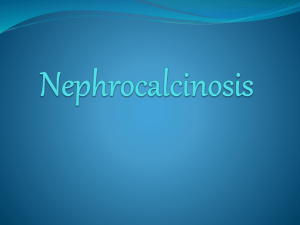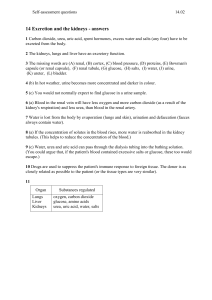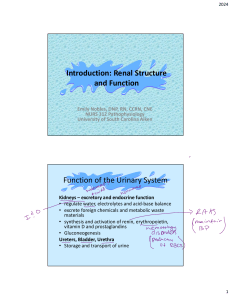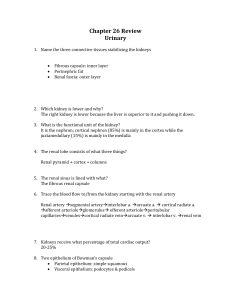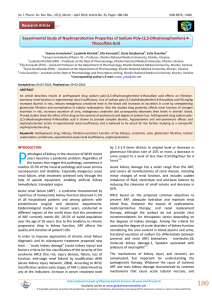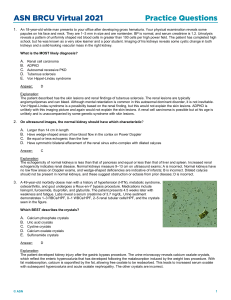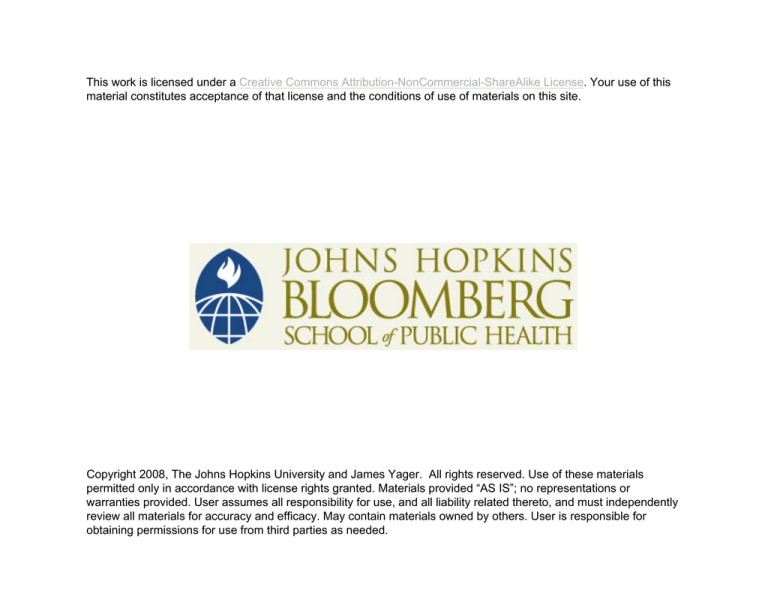
This work is licensed under a Creative Commons Attribution-NonCommercial-ShareAlike License. Your use of this
material constitutes acceptance of that license and the conditions of use of materials on this site.
Copyright 2008, The Johns Hopkins University and James Yager. All rights reserved. Use of these materials
permitted only in accordance with license rights granted. Materials provided “AS IS”; no representations or
warranties provided. User assumes all responsibility for use, and all liability related thereto, and must independently
review all materials for accuracy and efficacy. May contain materials owned by others. User is responsible for
obtaining permissions for use from third parties as needed.
Section D
Kidney: Functions, Injury, Detection,
and Response
Kidney - Functions
• Removal and Excretion of toxic metabolic waste from
blood
• Regulation of homeostasis of organism
• Elimination/conservation of water and electrolytes
• Hormonal functions:
• renin production (regulation of blood pressure)
• erthropoietin production (regulation of Hb synthesis
• Vit. D (1,25 dihydroxycholecalciferol) formation
• Parathyroid hormone metabolism – Ca2+ regulation
Kidney Structures and Functions
Structure
Functions
Vasculature
• afferent arteriole
• efferent arteriole
Deliver blood to glomerulus
Drains glomerulus
Glomerulus
Filtration of blood (size and charge- selective
filter); Filtration rate = 125 ml/min (180 L/day)
Tubules
Selectively reabsorb 98-99% salts, H20,
glucose, amino acids
• Proximal
Reabsorption: water, glucose, Na. K, PO4, SO4,
amino acids, low molecular weight proteins
Secretion: organic anionic (-) and cationic (+)
compounds
•Loop of Henle
Urinary concentration
Descending portion: H2O leaves filtrate
Ascending: H2O impermeable; Na & Cl transport
Kidney Structures and Functions
Structure
Functions
Tubules cont’d
•Distal Tubule & Collecting Duct
Selectively reabsorb 98-99% salts,
H20,
Urine formation: final regulation and
fine tuning of urine composition
Substance
Filtered/day
% Reabsorbed
Glucose (g/day)
Bicarbonate (meq/day)
Na+ (meq/day)
Cl- (meq/day)
H2O (L/day)
Urea (g/day)
Creatinine (g/day)
180
4,320
25,560
19,440
169
48
1.8
100
>99.9
99.4
99.1
99.1
50
0
Kidney (nephro) Toxicants
Metals
•Cadmium
• Mercury
• lead
Halogenated Hydrocarbons
• CCl4
• Chloroform
• Methoxyflurane (surgical anesthetic)
• Perchlorethylene
Other Chemicals
• MTBE (methyl-tert-butyl ether) (Gasoline additive)
• Acetaminophen
• Various antibiotics
Specificity of Renal Injury
Various nephrotoxicants cause site-selective injury
Mechanistic Basis
• Complex
• Blood flow
• Transport mechanisms
• Biotransformation capability of various regions
• Physicochemical properties of chemicals
• Specific functions of the cells in region
Detection of Renal Toxicity – Endpoints/Biomarkers
Symptoms
• Acute Renal Failure
Alterations in excretion of wastes
•Glomerular filtration rate
• Use of inulin (5,200 mwt polymer)
• Renal plasma flow
• Some organic acids (complete removal from plasma)
• Additional tests
• pH, volume, glucose, salts (Na, K)
Response to Xenobiotics and Repair of
Renal Toxicity
Kidney has regenerative capacity
Injury to Nephron
Uninjured Cells
Hypertrophy
Injured Cells
Cellular
Adaptation
Proliferation
Re-Epithelialization
Death
Repair
Cellular Adaptation
Differentiation
Structural and Functional Recovery

